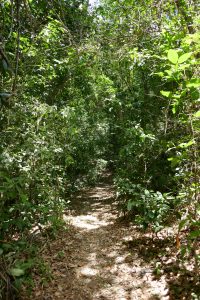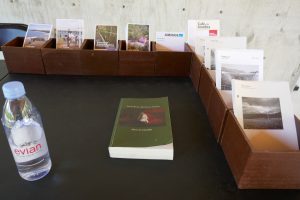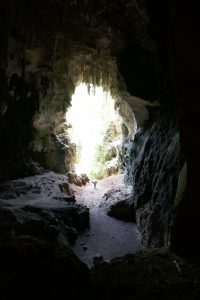In a 2015 Artforum interview, the artists described the artwork not as an act of appropriation, but of recontextualization:
In order to get to Puerto Rican Light (Cueva Vientos), one has to drive along the southwest coast of the island and pass a large petrochemical complex that has been abandoned since the 1970s. It now stands as a modern ruin—polluting and haunting the landscape. Cueva Vientos, a few miles down the road, is part of a natural protected area conserving multiple species of endemic flora and fauna. The mouth of the cave where we installed Flavin’s work is nearly two hundred feet tall, and the domed vault where the work is installed is about 250 feet at its highest point. The eight-foot-tall vertical shafts of fluorescent light, however, are not diminished by the grandeur of the space; rather, they charge the immense volume with their magnificent glow. At the top of the dome are two openings. At noon, the sunlight comes through them and hits the ground close to the Flavin sculpture, slowly moving like a sundial around the floor and the walls in a play of light. Sunlight—the primary material of our work, which we collect through solar panels outside the cave and use to power the Flavin sculpture—dances around the glowing fluorescent lamps. Then, around 3:00 PM, the sun seeps in from the entrance of the cave. Shadows come in long over the floor. Variations of natural light, in contrast with the fluorescent lamps, alternately reveal different aspects of the cave’s stalactites, the walls, and its bats—making the space and its inhabitants comprehensible.
In their words, the original artwork by Flavin was created during the era when the U.S. most heavily industrialized Puerto Rico. The cave is thus surrounded by the imprints of that process as much as it is by blight—aging highways, crumbling sidewalks, and deteriorating buildings. Much of Puerto Rico is like a modern ruin, developed, but suffering the ills of economic decline and disinvestment. In September of 2016, Ponce was subject to an electrical blackout, leaving 1.5 million homes and businesses without power for around four days. The outage was even visible from space. As Allora remembered, ‘one light still shone brightly,” referring to the solar powered Puerto Rican Light that irradiated the cave. This constancy of light in the face of the electrical grid’s failure, was, in Gotthard’s words, a particularly timely political statement. By running on “batteries fed by the Puerto Rican sun,” the artwork “didn’t depend on the island’s government-run power plants.” It symbolized an act of independence, of metaphorical and actual light when darkness hit.
Just under a month after I visited Puerto Rico, Hurricane Maria made landfall; I had already written the first post in this series when Hurricane Irma was making impact. From the safety of the continental U.S., I watched the Hurricane unfold in a media deluge, though in those first days nobody could predict the dire circumstances that would follow, nor the inadequacy of the U.S. government to provide necessary and timely aid, even after the lessons of Hurricane Katrina or the 7.0 magnitude earthquake that rocked Haiti in 2010. The USNS Comfort, the only U.S. Naval Ship in the area did not arrive in Puerto Rico until 11 days after the fact. When the Category 5 storm made a direct hit on the island unleashing 30 hours of wind and rain, it wiped out the electrical grid, destroyed infrastructure, cut off much needed access to food and potable water and left behind over 3 million cubic yards of debris. As of early November, almost of a month and a half later, the death count was officially 54, but Carmen Yulín Cruz, the governor of San Juan, estimated that the death toll was likely ten fold. As she waded through flooded streets, Cruz also faced Trump’s ire, a whole other story that has unspooled against the backdrop of a toxic and decaying masculinity.
Puerto Rico’s lack of immediate resources was no surprise given the territory’s already crippling debt, a problem that stems from an uneven economic and political relationship with the U.S. since annexation and later Operation Bootstrap. Two years ago, Cruz made this point clear when she told Congress that it had limited Puerto Rico’s self-determination:
“Puerto Rico has been denied these tools far too long…And as long as our options are defined by the powers of this Congress, we will always be at your mercy. The measure of our success will always be limited by the vastness of your control over our affairs.”
I had been thinking about the socio-economic position of Puerto Rico, its recent bankruptcy, and whether or not an artwork could become a meaningful gesture amidst this landscape since spending two weeks on the Island in August. It wasn’t until Hurricane Maria, however, that I dedicated more mental space to considering whether Puerto Rican Light (Jeanie Blake) could, as Gotthardt and the artists claim, still function as a political gesture with any weight.
I suppose what I’ve struggled with as an arts writer is considering the implications of an artwork’s meaning under rapidly changing circumstances, like a natural disaster. How, in other words, do artworks like Puerto Rican Light stand as gauges for a certain culture’s crises and successes. While artworks can make statements that feel meaningful one moment, they might become completely insubstantial in another. This isn’t an argument about art in general, but about how, amidst the catastrophe that has continued to unfold in Puerto Rico even before Maria made landfall, recontextualizing a Dan Flavin sculpture in a far flung cave in the barrio of Magas of Guayanilla and situated in the broader Cuevas Convento system actually feels apolitical. Indeed, when the work was functional, it made a statement few could hear much less feel the impact of.
This was an issue that I had and continue to have with another Dia-sponsored project: de Maria’s The Lightning Field in New Mexico. That particular artwork requires a pilgrimage from the outside, typically from the east and west coast to a far flung corner of New Mexico. While the artist claimed that the environment was fundamental to the artwork, its seclusion upholds the modernist tendency to keep artwork from the din of an outside world. The romanticization of land based art from the 60s and 70s was rooted in the belief that artists could shift the terms of our engagement with art; they could put it in places that were far off the beaten path thus making viewers go toward wholly new and more difficult ends to reach them. That experience of a so-called pilgrimage was crowned by encountering works that were made on an environmental scale. In an article for Pastellegram, I wrote about this phenomenon:
As the San Francisco-based journalist Kenneth Baker once put it, The Lightning Field was a direct response to the Cold War, a need to use beauty as a bulwark against the potential for global annihilation. “Beauty,” he explained, was “ the opposition to historical reality.” Aesthetic experience, in his estimation, offered refuge from contemporary upheaval and from politics itself. He went on to posit, unironically, that a solitary experience in The Lightning Field gave one a sense of what existence might be like after the apocalypse. Los Alamos National Laboratory, the center of modern science and the originator of the world’s first atomic bomb, is but 200 miles away. Despite the proximity of the two sites, The Lightning Field and other artworks of the era in many ways signaled a Cold War isolationism that paralleled such cultural phenomena as the “back to the land” movement in the same years. The Lightning Field played into that discourse and continues to do so by reinforcing the notion that transcendent aesthetic experience is only encountered outside of the broader political and social world.
 As I reach back through that earlier writing to think about Puerto Rican Light, I have a come to the conclusion that when certain artworks depend on isolation as one of their primary components, that isolation can read as isolationism, a result of an art-world elitism that hinges upon visitors and outsider experience. I was one of those outsiders, someone who came from afar to see a Dan Flavin sculpture in a cave. And while the concept of the artwork was initially compelling, even thrilling, what I later found was a sense of feeling underwhelmed by the actual artwork at hand, and totally captivated by the jungle’s flora and fauna and by the cave’s massive bat colony. I realized that I had become enamored of the idea of Puerto Rican Light, as many might, despite my own earlier criticisms of The Lightning Field.
As I reach back through that earlier writing to think about Puerto Rican Light, I have a come to the conclusion that when certain artworks depend on isolation as one of their primary components, that isolation can read as isolationism, a result of an art-world elitism that hinges upon visitors and outsider experience. I was one of those outsiders, someone who came from afar to see a Dan Flavin sculpture in a cave. And while the concept of the artwork was initially compelling, even thrilling, what I later found was a sense of feeling underwhelmed by the actual artwork at hand, and totally captivated by the jungle’s flora and fauna and by the cave’s massive bat colony. I realized that I had become enamored of the idea of Puerto Rican Light, as many might, despite my own earlier criticisms of The Lightning Field.
As I hiked out there with the staff of the organization that is hosting Puerto Rican Light, Para la Naturaleza, I felt the pool of another one of the artwork’s less visible component: labor. As in the case of de Maria’s installation, Puerto Rican Light relied on a local population to keep the artwork running; initially 14 men were required for the installation, which isn’t surprising given that solar panels were installed on the cave. Otherwise, Para la Naturaleza, has largely remained in the shadows, despite their role as both guides to the site, botanists, biologists and scientists working to preserve and protect Puerto Rico’s natural habitats.
We believe in the transformative power of nature, its generosity, magnificence and splendor. We believe that our progress depends on making sure we protect and conserve it.
Because of this, our common goal is making sure that 33 percent of Puerto Rico’s natural ecosystems are protected by the year 2033.
Both the contiguous United States and Costa Rica dedicate 26 percent of their land to conservation, and our Antillean neighbors in the Dominican Republic protect 24 percent, with Cuba protecting 17% and the US Virgin Islands—whose economy depends largely on tourism—protecting nearly 52% of its territory.
The total amount of land protected in Puerto Rico by both government and private entities is only 8 percent. Our goal is ambitious and long term, but we believe we can make it possible if it becomes everyone’s common goal.
 When I spoke the the two employees (both biologists) who were working at the Para la Naturaleza site the day of my arrival, I realized that it was their labor that kept the artwork alive so to speak. Everyday, they would carry in the large inverter that was necessary for the solar panels to store energy for the battery pack. The apparatus was fifty pounds and required two people who would hike it out at the end of the day as well. The hike in was beautiful, but also required helmets and careful footing through a dense jungle environment. And so as I began thinking of the artwork, the metaphor and actuality of light amidst metaphorical and actual darkness seemed less workable or even true. Another dynamic surfaced in my eyes that was tied to labor, the labor required to make art work. Indeed several artists have broached this question elsewhere-how security guards, janitors, and other behind-the-scenes labor keep museums running. Here the situation is slightly different and is tied directly to these kinds of works that depend on experiential engagements in difficult to reach places.
When I spoke the the two employees (both biologists) who were working at the Para la Naturaleza site the day of my arrival, I realized that it was their labor that kept the artwork alive so to speak. Everyday, they would carry in the large inverter that was necessary for the solar panels to store energy for the battery pack. The apparatus was fifty pounds and required two people who would hike it out at the end of the day as well. The hike in was beautiful, but also required helmets and careful footing through a dense jungle environment. And so as I began thinking of the artwork, the metaphor and actuality of light amidst metaphorical and actual darkness seemed less workable or even true. Another dynamic surfaced in my eyes that was tied to labor, the labor required to make art work. Indeed several artists have broached this question elsewhere-how security guards, janitors, and other behind-the-scenes labor keep museums running. Here the situation is slightly different and is tied directly to these kinds of works that depend on experiential engagements in difficult to reach places.
When I revisited the Para la Naturaleza’s website, there were no events (ie. reservations for Puerto Rican Light available) as had been the case before the hurricane. Now, like most of the country, Para la Naturaleza is dedicated to the task of rebuilding.
In Puerto Rico, the task at hand it urgent, especially since much of the territory’s infrastructure—the electrical grid is a prime example—has had longstanding problems that originated long before the hurricane. In recent years, the Puerto Rico Electric Power Authority (PREPA) has been crippled by debt with Puerto Ricans shelling out more money per kilowatt of electricity than most Americans. Just this summer, PREPA filed for bankruptcy and when Hurricane Maria hit, their outdated infrastructure of power lines, transmission towers and substations, all above ground, received the brunt of the damage.
Much of Puerto Rico’s livelihood and survival hinges upon light and access to it. For the artists, who spoke about the artwork’s outright reliance on light, the artwork gestures to this fraught history of electricity on the island:
Our work ultimately is about trying to render physical the words Puerto Rican Light. For instance, the current Puerto Rican debt crisis mainly stems from the country’s largest electric company. There are energy transfers that occur within the photovoltaic cells of the solar panels and within the fluorescent lamps as well as within the ecosystem of the cave itself. Flavin’s piece is traditionally perceived as dependent on the institutional setting or white cube. Here, we are opening that gap between object and setting, examining their reciprocal influence, and exploring the overlapping of the prehistoric and the contemporary.
With Hurricane Maria, Puerto Rican Light has taken on another significance, beyond Jeanie Blake’s first experience of the New York City Parade, or even of Dan Flavin’s attempt to make light into sculpture. That significance goes beyond the transfer of photovoltaic cells to solar panels. For me it is about regulation, access and infrastructure. In that way, the artwork didn’t depend on PREPA for electricity, circumventing a power structure with known deficits. But it did depend on labor, the labor of those who kept the art working when the artists and institutions were occupied elsewhere. Now more than ever, labor is keeping the island alive in the wake of catastrophe. Along those lines, most of the territory is left with the task of rebuilding a place that even before the hurricane was riddled with inadequate infrastructure. All this is going on while Congress debates what kind of aid package is necessary. Just over the summer, Congress had passed the Puerto Rican Oversight Management and Economic Stability Act (PROMESA) installing a board composed mostly of foreigners to “determine the best course” for the Island’s economic state.

